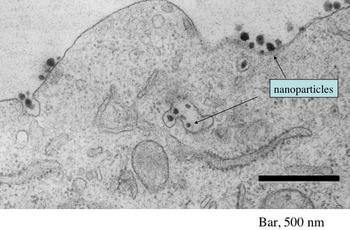
Maybe you’ve read about the amazing “cancer-killing nanobots” from Caltech that use RNA as a weapon. They’ve been making waves in news media all week. The truth is that many headlines, and stories, are grossly misleading. Caltech, along with biotech firm Calando, has developed a method of using nanoparticles to cause RNA interference in cancer cells. The news has caused a nice jump in the stock of Calando’s parent company, Arrowhead Research (NASDAQ: ARWR). But all the talk about Caltech striking a major blow against cancer is premature. We don’t know if this RNA interference will actually destroy cancer cells, or even be safe to use because it’s still in phase I clinical trials. As often happens with science linked to cancer research, the media has over-hyped a promising technology, pressuring it to perform before it is able.
What’s even more aggravating is the often hilarious misuse of the term ‘nanobots’. Look at some of these headlines:
- Human-Tested Nanobot Delivers New Cancer Therapy With Success!
- Cancer Gene Therapy by Nanotech Robots
- Nanobots Flip Off Cancer Switch in Cells
- Tiny Robots Deliver Gene Therapy To Treat Cancer
- Nanotech robots deliver gene therapy through blood (from Reuters no less!)
or the even more unfortunate rehash:
‘Nanobots’ conjures up images of tiny little robots in the minds of readers, maybe even tiny little spaceships floating through the body. That’s just not what Calando created. Their nanoparticle is a 70nm spheroid with RNA embedded inside. When it’s absorbed into a cell, the particle falls apart, releasing the RNA. If we have to use a bad metaphor for it wouldn’t Trojan Horse be more apt? Maybe nano-grenade?

The truth is that the first real ‘nanobots’ we use aren’t even going to look like robots. They’ll be our own cells that have been commandeered to perform other tasks, or they’ll be tiny spheres that float through the body and act very similar to cells or other biological systems.
Even forgetting the nanobot issue, I still think the Caltech research is being over-hyped. The nanoparticle has been found to reliably show up in cancerous cells and deliver strands of RNA that disturb the creation of a certain protein. According to the paper recently published in Nature, this is the first time that a nanoparticle has been shown to systematically appear in higher levels in a cancer cell as the dose to a patient increases. The Caltech/Calando nanoparticle system is called RONDEL, and according to Nature News, it targets cancer cells by the “leaky” blood vessels that often connect to them. While that targeting method now has proven dose-dependence (that is, more nanoparticles in blood equals more in cancer cells), there’s no reliable measure of its potency. Does it kill cancer cells? Does it even slow their growth? Is this RNA interference actually going to be an effective treatment?
For that matter, we don’t know anything about it’s safety either. Does it ever target the wrong cells? Doctors have biopsied skin melanomas (the cancer used in the trials) and found RONDEL in good amounts, but I can’t find any mention of how often it makes its way into non cancerous cells.
RONDEL delivers RNA, a special version (siRNA) that is double stranded and that interacts with a cell’s programming to “turn off” a certain protein. That’s a very cool system, and the original discovery of this RNA interference earned the 2006 Nobel Prize in Medicine (for work performed in 1998). The biopsies of cancer cells showed all the signs of RNA interference: cleaved RNA strands, lower protein levels (in one case), and disrupted messenger RNA. That’s great, but again, we have no idea if this RNA interference will translate into real-world benefits for a patient.
The problem is that we’re talking about only one aspect of a phase I clinical trial that isn’t even over yet. We won’t know the results (i.e. safety and efficacy) until later in the year. And the trial is only on 15 patients. That’s a tiny dataset. It would take phase II and phase III (years of testing) before we’re sure this is really a proven way to “fight-cancer”. The discovery of nanoparticles in cancer cells is like knowing gasoline got to the engine in your car. It’s an important step, but it doesn’t give us any clue as to whether or not the car is actually driving down the road.
Caltech’s research and Calando’s nanoparticle are promising. A reliable means of creating RNA interference in a cell could be a great mechanism to fight cancer, to provide gene/protein therapy, and may have other powerful applications. It’s just too soon to know how reliable RONDEL is at the moment. Dose-dependence is just one factor we care about, we also need to know how selective that delivery is. And we have no idea about how effective this particular RNA interference trial will be in actually fighting cancer. It’s just too soon to say. For now, let’s praise this research for creating a RNA interference delivery system with proven dose-dependence and call it a day.
[Image credits: Caltech: Swaroop Mishra, Derek Bartlett]
[source: California Institute of Technology, Calando Pharmaceuticals, Nature]


